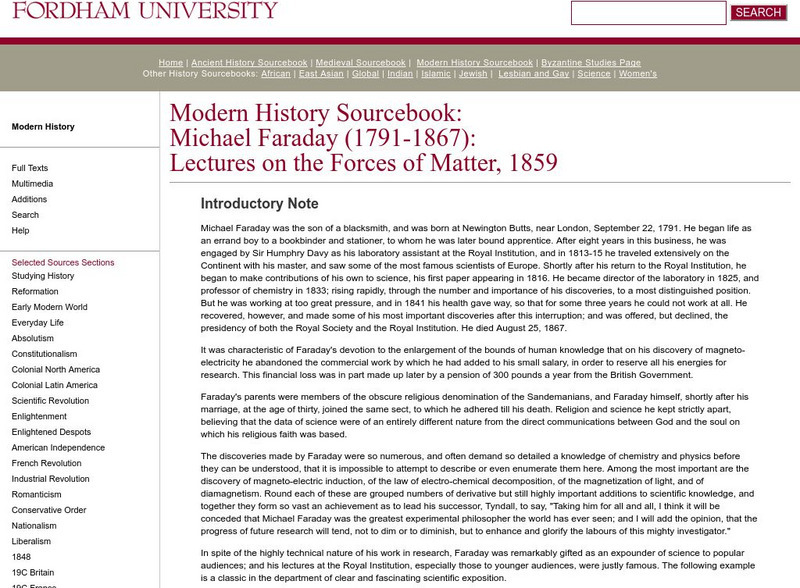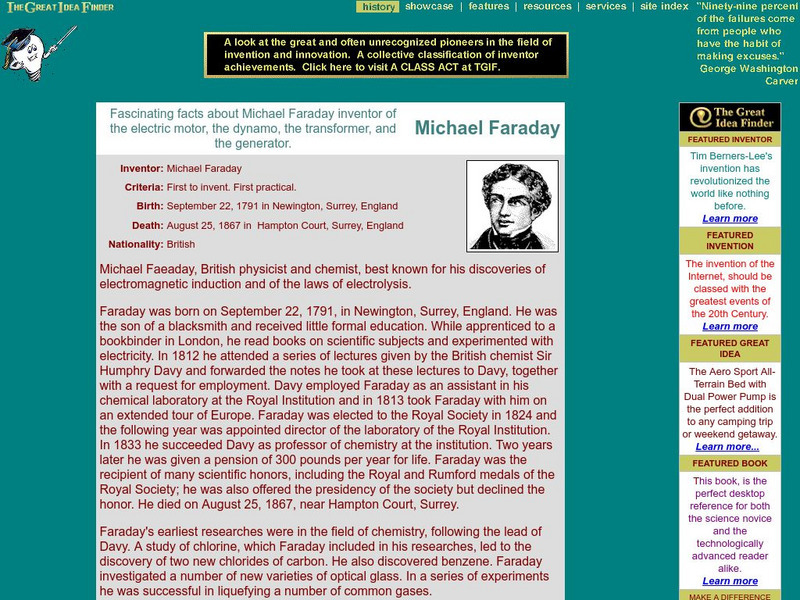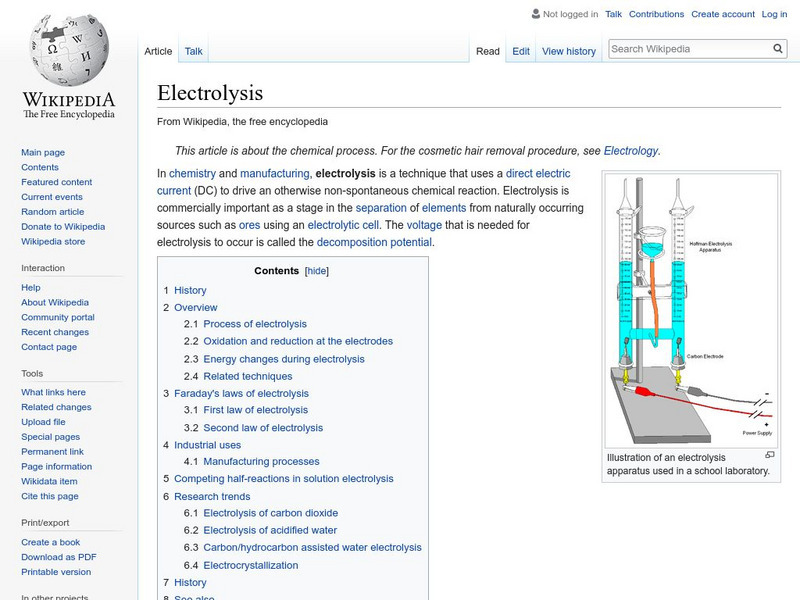Curated OER
Electromagnetism - Electromagnetic Induction
Young scholars investigate electromagnetic induction. In this physics lesson, students construct Faraday's coil to observe what happens when a wire moves through a changing electromagnetic field. They complete lab report and present...
Simon Fraser University
Chem1 Virtual Textbook: Electrolytic Cells and Electrolysis
As part of the General Chemistry Virtual Textbook, this site examines a variety of topics related to electrochemistry. In a discussion of electrolysis, this site covers topics including electrolysis in aqueous solutions, Faraday's laws...
Energy for Sustainable Development
Esd Bulgaria: Kids & Energy: Energy Pioneers: Michael Faraday (1791 1867)
A profile of Michael Faraday, a British scientist who discovered electromagnetic induction, which made it possible to develop the technology for generating electricity. He produced many other inventions, some of which are described here.
Internet History Sourcebooks Project
Fordham University: Modern History Sourcebook: Michael Faraday (1791 1867)
Contains brief biographical information on Michael Faraday, as well as the text of the following lectures delivered by Faraday: The Force of Gravitation, Gravitation-Cohesion, Cohesion-Chemical Affinity, Chemical Affinity-Heat,...
Great Idea Finder
The Great Idea Finder: Michael Faraday
A solid biography of good length and history of Faraday's work. Complete, readable, thorough. Picture. Lots of links to other sources, including Joseph Henry's claim that *he* was first, and another about Faraday's kinetic flashlight!
Florida State University
Florida State University: Magnet Lab: Faraday Cage
A faraday cage is an important tool for some scientists at the MagLab. But they don't work with it: they work inside it.
National High Magnetic Field Laboratory
Magnet Academy: Faraday's Ice Pail
Out of a humble ice pail the great experimentalist Michael Faraday created a device to demonstrate key principles of attraction, repulsion and electrostatic induction. (Java tutorial)
National High Magnetic Field Laboratory
Magnet Academy: Faraday Motor
Just a year after electromagnetism was discovered, the great scientific thinker Michael Faraday figured out how to turn it into motion. (Java tutorial)
National High Magnetic Field Laboratory
Magnet Academy: Electromagnetic Induction
In 1831, Michael Faraday carried out numerous experiments to prove that electricity could be generated from magnetism. He not only demonstrated electromagnetic induction, but also developed a good conception of the processes involved....
National High Magnetic Field Laboratory
Magnet Academy: Michael Faraday
A self-educated man with a brilliant mind, Michael Faraday was born in a hardscrabble neighborhood in London. Through the combination of insatiable curiosity and a powerful will to succeed, he transcended his austere beginnings to...
Wikimedia
Wikipedia: Electrolysis
Wikipedia offers a short explanation of the how the electrolysis process works with links to some of the scientific pioneers of electrolysis.
Other
Michael Faraday
Provides information about the achievements of the English chemist and physicist Michael Faraday who is "known for his pioneering experiments in electricity and magnetism."
National High Magnetic Field Laboratory
Magnet Academy: Faraday Motor 1821
Few inventions have shaped technology as much as the electric motor, but the very first version - the Faraday motor - didn't look anything like the modern motor.
University of Wisconsin
University of Wisconsin: 4 Electricity
A description of several demonstrations for static electricity concepts. The demonstrations utilizing the Telsa coil, Faraday cage, and Van de Graaff generator are ideal for demonstrating electric potential concepts. Suitable for student...
Victorian Web
Victorian Web: Conservation of Energy and Thermodynamics
This site is about the trace of the evolution of historical ideas concerning energy conservation and the laws of thermodynamics.
Curated OER
Photo of Michael Faraday
Contains an article on the life of scientist Michael Faraday and highlights his work in the study of electormagnetism.














